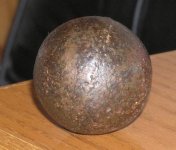Back in the 60's I found this round solid ball that is 1 3/4" round and weighs 14.5 ounces in the dirt here in Kansas and I always wondered if it was a Civil War ball. I'm hoping that someone here would be able to tell if this is CW. It's not perfectly round but it appears that it was created from a mold that had two half's and they were off center just a bit then ground down to make it a round as possible. We may not know exactly what it is but I thought I would ask. Thanks for replying.
You are using an out of date browser. It may not display this or other websites correctly.
You should upgrade or use an alternative browser.
You should upgrade or use an alternative browser.
1 3/4" ball weight 14.5 oz. CW Ball???
- Thread starter rmccrea
- Start date
Mccrae, welcome to the Civil War Bullet Forum. 
I wish I had happier news to give you about the ball. But, going by the diameter and weight measurements you've reported, it is not any kind of artillery projectile (cannonball, Grapeshot-ball, or Canister ball).
Here's why:
Because literally millions of round (and "round-ish) metal balls exist which are NOT artillery projectiles, we cannonball collectors rely on the US (and CS) Ordnance Manual, which gives the extra-precise diameter and weight measurements of all American (and British) cannonballs, Grapeshot balls, and Canister balls that were used from 1776 through the civil war. Put simply, if a ball does not match up with the precise size AND precise weight of one of the balls listed in the Ordnance Manual, it is not a cannonball or Grapeshot ball or Canister ball made in America or Britain.
Here's a link to the Ordnance Manual's diameter-&-weight Specifications charts (which were called the Shot Tables):
Descriptions of shot for smoothbore guns
You say your ball's diameter is 1.75-inches, and it weighs 14.5 ounces. There is no match-up for it anywhere in the Shot Tables. The only ball "nearby" your ball's size-&-weight is an 18-pounder caliber Canister ball (smaller and lighter than yours), and a 24-pounder caliber Canister ball (larger than yours, but LIGHTER than yours).
You may be wondering... how can a solid (not hollow) iron ball which is larger than my ball weigh less than my ball? The answer is, your ball is not made of iron, but of Steel -- which is heavier than plain iron.
So, you may now be wondering, what was my Steel ball made for? The answer is, it's a rock-crusher ball, from the 20th-century Stonemilling Industry. Steel balls are preferred for rock-crushing, because they are a much "tougher" metal than cast-iron.
Regards,
Pete [P.C. George]
I wish I had happier news to give you about the ball. But, going by the diameter and weight measurements you've reported, it is not any kind of artillery projectile (cannonball, Grapeshot-ball, or Canister ball).
Here's why:
Because literally millions of round (and "round-ish) metal balls exist which are NOT artillery projectiles, we cannonball collectors rely on the US (and CS) Ordnance Manual, which gives the extra-precise diameter and weight measurements of all American (and British) cannonballs, Grapeshot balls, and Canister balls that were used from 1776 through the civil war. Put simply, if a ball does not match up with the precise size AND precise weight of one of the balls listed in the Ordnance Manual, it is not a cannonball or Grapeshot ball or Canister ball made in America or Britain.
Here's a link to the Ordnance Manual's diameter-&-weight Specifications charts (which were called the Shot Tables):
Descriptions of shot for smoothbore guns
You say your ball's diameter is 1.75-inches, and it weighs 14.5 ounces. There is no match-up for it anywhere in the Shot Tables. The only ball "nearby" your ball's size-&-weight is an 18-pounder caliber Canister ball (smaller and lighter than yours), and a 24-pounder caliber Canister ball (larger than yours, but LIGHTER than yours).
You may be wondering... how can a solid (not hollow) iron ball which is larger than my ball weigh less than my ball? The answer is, your ball is not made of iron, but of Steel -- which is heavier than plain iron.
So, you may now be wondering, what was my Steel ball made for? The answer is, it's a rock-crusher ball, from the 20th-century Stonemilling Industry. Steel balls are preferred for rock-crushing, because they are a much "tougher" metal than cast-iron.
Regards,
Pete [P.C. George]
Last edited:


